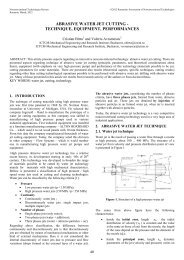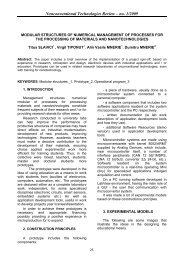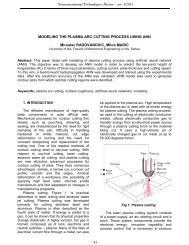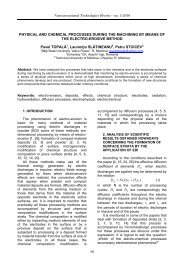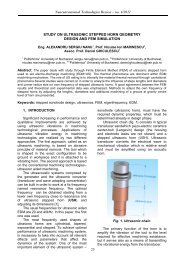Electro-Spark Coating with Special Materials - nonconventional ...
Electro-Spark Coating with Special Materials - nonconventional ...
Electro-Spark Coating with Special Materials - nonconventional ...
You also want an ePaper? Increase the reach of your titles
YUMPU automatically turns print PDFs into web optimized ePapers that Google loves.
The operator has full control over the<br />
process, during its run time. It is a cold<br />
coating process, <strong>with</strong>out heating the base<br />
metal, so that no distortion occurs. The<br />
coating rate is 17,4... 18,6 g / h.<br />
B. <strong>Electro</strong>-spark coating <strong>with</strong> an<br />
aluminium electrode<br />
On a sample <strong>with</strong> the sizes 60 mm x 50<br />
mm x 25 mm of the same base metal, some<br />
coatings were also performed, using an 1.6<br />
mm diameter aluminium electrode [6]. The<br />
applied parameters were in the ranges<br />
mentioned in the previous example. In 20<br />
min, a coating of approximately 8mm x 12mm<br />
<strong>with</strong> continuous aspect is made on the base<br />
metal sample. The thickness of the coating is<br />
estimated at 0.05...0.15 mm. The deposition<br />
rate is 18... 25 g / h.<br />
C. <strong>Electro</strong>-spark depositing <strong>with</strong> tungsten<br />
carbides<br />
In an experiment [7,8], the coatings were<br />
realized by the electro-spark process, using a<br />
WC-Co (97% WC and 3% Co) electrode <strong>with</strong><br />
a cross-section of 3 x 4 mm (connected to the<br />
anode), onto rings made of carbon steel C45<br />
(connected to the cathode) [7,8].<br />
The EIL-8A model was used as equipment<br />
for ESD, <strong>with</strong> the following parameters:<br />
· voltage U = 230 V,<br />
· capacitor C = 300 μF,<br />
· current intensity I = 2.4 A.<br />
The quality of electro-spark deposition<br />
depends mainly on the shape, duration, and<br />
average value of current or pulse power.<br />
Then, the coatings were treated <strong>with</strong> an<br />
Nd:YAG laser (impulse mode), model BLS<br />
720, <strong>with</strong> the following parameters:<br />
· laser spot diameter: d = 0.7 mm,<br />
· laser power: P = 20 W,<br />
· traverse speed: v = 250 mm/min,<br />
· nozzle-workpiece distance: Df = 1 mm,<br />
· pulse duration: ti = 0.4 ms,<br />
· pulse repetition frequency: f = 50 Hz,<br />
· laser beam shift jump: S = 0.4 mm.<br />
5. RESULTS AND DISCUSSION<br />
5.1. Analysis of the coating morphology<br />
A. In the case of the electro-spark coating<br />
<strong>with</strong> a stainless steel electrode, Fig.5<br />
presents the structure of the stainless steel<br />
coating (magnification 250 X). The structure<br />
is relatively uniform. The structural<br />
constituents are austenite and delta ferrite<br />
Nonconventional Technologies Review – no. 1/2011<br />
60<br />
(4...6% content), spread relative uniformly in<br />
the coating. There are white and black zones,<br />
coresponding to these structural constituents.<br />
No defects, as cracks, lack of material,<br />
inclusions of other materials. This means, at<br />
this magnification of the microscope, that the<br />
material is uniformely overlayed on the base<br />
metal surface.<br />
Fig. 5. <strong>Electro</strong>-spark coating <strong>with</strong><br />
stainless steel on carbon steel (250 X) [6]<br />
Fig. 6. <strong>Electro</strong>-spark coating <strong>with</strong><br />
aluminium on carbon steel (250 X) [6]<br />
B. In the case of the electro-spark coating<br />
<strong>with</strong> an aluminium electrode, as presented in<br />
the microstructure of fig.6, the following<br />
structural costituents are detected: metal<br />
matrix of poly-crystalline aluminium, <strong>with</strong><br />
poly-crystalline silicon grains and aluminiumsilicon<br />
eutectoid at the grain boundary.<br />
Inclusions of silica (silicon oxide) and alumina<br />
(aluminium oxide) are observed, which arised<br />
from the elaboration of the aluminium batch,<br />
in the continuous casting of the wire, that<br />
then was cold drawn to 1.6 mm diameter<br />
wire, of which the electrode applied here was



